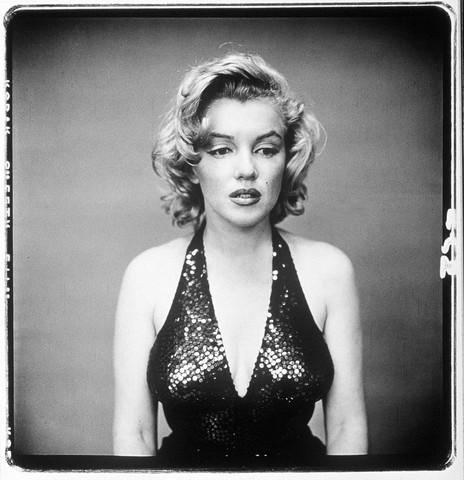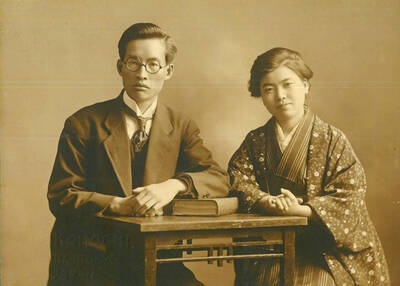Feminine beauty has been celebrated across the ages, but an enduring belief is this: what constitutes attractiveness in a woman cannot be pinned down — it depends on the prevailing fashion, culture or ethnicity and on the eye of the beholder.
For instance, in Victorian England, a tiny, puckered mouth was the zenith of pulchritude.
Today, the rosebud look has been replaced by what has been called the trout look, as women in Western cultures strive to make their mouths look as wide and full-lipped as possible.

PHOTO: NY TIMES NEWS SERVICE
In many societies, the focus of secondary erogenous zones has roamed over ankles, necks and knees and makeup and hairstyles change according to the mode.
The desired female morphology has shifted too, driven in part by prosperity and the social advancement of women. In the 1950s, Marilyn Monroe was the template of feminine beauty; today, she would be encouraged to sign up at Weightwatchers.
So it would seem that the "beauty standard" does not exist — that there is no eternal benchmark, only a chaotically whizzing merry-go-round.
Not so for evolutionary psychologists.
For them, fashion is a fluffy cover for a force that is deeper, remorseless and unchanging, as old and enduring as our genes: the Darwinian drive of survival and genetic fitness.
In an innovative test of these rival hypotheses, scientists at the University of Texas at Austin and at Harvard University trawled through three centuries of English-language literature and through three Asian literary classics dating back nearly two thousand years.
Their goal: Which parts of the woman's body were praised as beautiful by writers across the ages?
Their sources were a Web site, Literature Online, for English literature from the 16th, 17th and 18th century; Chinese sixth dynasty palace poetry (from the fourth to the sixth century AD) and two ancient Indian epics, the Mahabharata and the Ramayana, from the first to third century AD.
Breasts, buttocks and thighs — the primary erogenous zones — predictably featured large in these descriptions.
But a slim waist trumped them all.
In English literature, a glowing description of a narrow waist (a waist "as little as a wand", "beholden to her lovely waist" and so on) showed up 65 times.
That compared to 16 references for romantic description of breasts, 12 for thighs and a mere two apiece for hips and buttocks.
Before anyone cries fattism, the literature was studded with romantic tributes to plumpness but relatively few to slimness.
But what counted, plump woman or slim, was the relative narrowness of the waist. There was not a single evocation of beauty that said the object of veneration had a bulging tummy.
In the Asian works, the slim waist was even more adored, although there was no flattering reference to plump beauty.
Narrow waistedness scored a massive 35 references in the two Indian epics, while the other body parts garnered a total of 26. In the Chinese poetry, the narrow waist was evoked 17 times, while breasts, buttocks, hips and thighs got zero, and there was a solitary romantic reference to a woman's legs.
The study, which appears in Proceedings of the Royal Society, a British journal, says these references show that a slim waist is an object of desire that spans time and cultures.
Why so?
The answer, suggest the authors, is that a narrow waist is a sign of strong health and fertility. Men instinctively assess a woman's waist for its potential for successful reproduction and thus furthering their own genes.
Modern research has established a link between abdominal obesity and decreased estrogen, reduced fecundity and increased risk of major diseases.
But "even without the benefit of modern medical knowledge, both British and Asian writers intuited the biological link between health and beauty," say authors, Devendra Singh, Peter Renn and Adrian Singh.
"In spite of variation in the description of beauty, the marker of health and fertility— a small waist — has always been an invariant symbol of feminine beauty."

In the next few months tough decisions will need to be made by the Taiwan People’s Party (TPP) and their pan-blue allies in the Chinese Nationalist Party (KMT). It will reveal just how real their alliance is with actual power at stake. Party founder Ko Wen-je (柯文哲) faced these tough questions, which we explored in part one of this series, “Ko Wen-je, the KMT’s prickly ally,” (Aug. 16, page 12). Ko was open to cooperation, but on his terms. He openly fretted about being “swallowed up” by the KMT, and was keenly aware of the experience of the People’s First Party

Aug. 25 to Aug. 31 Although Mr. Lin (林) had been married to his Japanese wife for a decade, their union was never legally recognized — and even their daughter was officially deemed illegitimate. During the first half of Japanese rule in Taiwan, only marriages between Japanese men and Taiwanese women were valid, unless the Taiwanese husband formally joined a Japanese household. In 1920, Lin took his frustrations directly to the Ministry of Home Affairs: “Since Japan took possession of Taiwan, we have obeyed the government’s directives and committed ourselves to breaking old Qing-era customs. Yet ... our marriages remain unrecognized,

Not long into Mistress Dispeller, a quietly jaw-dropping new documentary from director Elizabeth Lo, the film’s eponymous character lays out her thesis for ridding marriages of troublesome extra lovers. “When someone becomes a mistress,” she says, “it’s because they feel they don’t deserve complete love. She’s the one who needs our help the most.” Wang Zhenxi, a mistress dispeller based in north-central China’s Henan province, is one of a growing number of self-styled professionals who earn a living by intervening in people’s marriages — to “dispel” them of intruders. “I was looking for a love story set in China,” says Lo,

During the Metal Ages, prior to the arrival of the Dutch and Chinese, a great shift took place in indigenous material culture. Glass and agate beads, introduced after 400BC, completely replaced Taiwanese nephrite (jade) as the ornamental materials of choice, anthropologist Liu Jiun-Yu (劉俊昱) of the University of Washington wrote in a 2023 article. He added of the island’s modern indigenous peoples: “They are the descendants of prehistoric Formosans but have no nephrite-using cultures.” Moderns squint at that dynamic era of trade and cultural change through the mutually supporting lenses of later settler-colonialism and imperial power, which treated the indigenous as